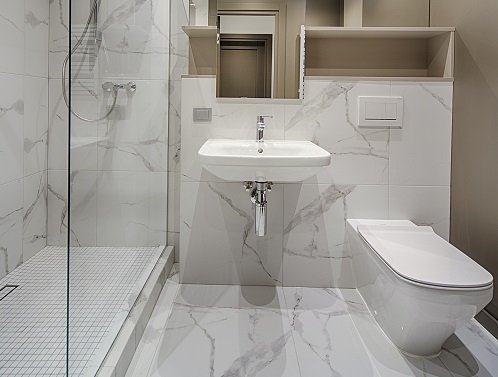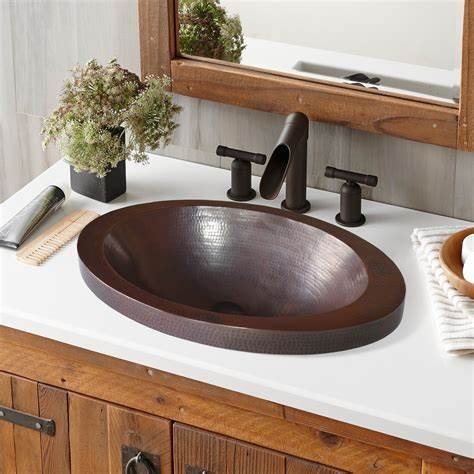Today, I’m thrilled to share my journey and discoveries on a topic that might seem mundane but is truly crucial for any establishment that deals with the arduous task of cleaning – the optimal mop sink faucet height.
My extensive experience in the cleaning industry has shown me how vital this little detail can be.
The optimal height for a mop sink faucet depends on factors such as the user’s comfort, the sink’s design, and the specific needs of the workspace.
In general, a good starting point is to install the faucet at a height of around 36 to 42 inches (91 to 107 cm) above the floor.
This height provides a comfortable working position for most users and allows for efficient use of the mop sink. However, it’s crucial to consider the size of the sink and the length of the mop handles used in your facility.
Some sinks may require a slightly higher or lower faucet installation to ensure that water flows effectively and minimizes splashing while accommodating various mop sizes.
Ultimately, the right height should prioritize user comfort, safety, and the practicality of the workspace.
How Mop Sink Faucet Height Affects Functionality
Before we get into the nitty-gritty of faucet heights, let’s explore the world of mop sinks and their purpose.
Mop sinks are the unsung heroes of clean establishments – the hidden, deep basins where mops and buckets find solace after a long day of battling dirt and grime.
They are essential for maintaining a clean and hygienic environment in various settings, including commercial kitchens, janitorial closets, hospitals, and laboratories.
Read more: How to Install a Bathroom Sink Drain
Role of Faucets in Mop Sink Functionality
Now, let’s give some well-deserved spotlight to the faucets. These seemingly humble fixtures play a pivotal role in the functionality of mop sinks.
Faucets provide the precious water that breathes life into our cleaning tools, enabling us to tackle the most stubborn stains and spills.
Whether it’s filling buckets, rinsing mops, or cleaning equipment, a well-placed and properly sized faucet can make a world of difference in how efficiently and effortlessly we can complete our cleaning tasks.
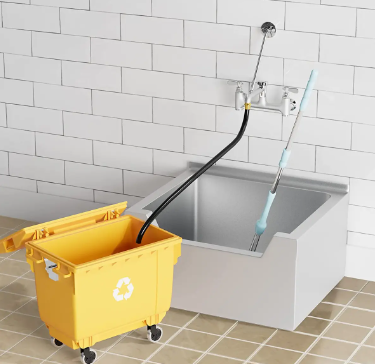
Read more: Mushroom Growing in Sink Drains: How to Fix the Problem
Common Issues Arising from Improper Faucet Height
You might wonder, “Why does mop sink faucet height matter so much?” Well, my friends, imagine this scenario: you’re at work, armed with a mop, ready to conquer the floor like a fearless warrior.
But alas! The faucet is too high, and you’re practically tiptoeing just to fill your bucket. Or maybe it’s too low, and you find yourself awkwardly crouching, feeling like a contortionist on a cleaning mission. Been there, done that, and it’s far from fun!
Improper mop sink faucet height can lead to numerous challenges and inconveniences. A faucet set too high can cause excessive splashing and water wastage, leading to slippery floors and potential accidents.
On the other hand, a faucet set too low can strain your back and cause discomfort, making cleaning a dreaded chore.
Read more: 10 Best Double Sink Bathroom Vanities to Buy in 2024
The Ideal Mop Sink Faucet Height
Tod determine the correct height for a mop sink faucet, consider the following:
Ergonomics and User Comfort Considerations
The secret sauce to comfort and efficiency lies in the world of ergonomics. When it comes to mop sink faucets, the height matters more than you’d think.
The ideal mop sink faucet height should allow the user to fill buckets and rinse mops comfortably, with minimal strain on the body.
This means the faucet should be positioned at a height that allows for easy access without requiring excessive bending or stretching.
Compliance with Industry Standards and Regulations
Now, let’s talk about compliance. The importance of adhering to industry standards and regulations cannot be overstated.
Fortunately, various organizations, such as the Occupational Safety and Health Administration (OSHA) and the American National Standards Institute (ANSI), provide guidelines for proper mop sink faucet height in commercial and industrial settings.
These standards are designed to prioritize user safety, prevent accidents, and enhance overall efficiency.
Read more: How to Install a Bathroom Sink Drain
Factors Influencing the Optimal Mop Sink Faucet Height
To determine the perfect mop sink faucet height for you, you will need to consider a few factors:
User Height
The height of the primary users should be taken into account to ensure that the faucet is at a comfortable working level for most individuals.
Type of Cleaning Tasks
Consider the specific cleaning tasks performed at the mop sink. For example, if the sink is primarily used for mopping floors, a lower faucet height may be more suitable, while a higher faucet may be required for filling large containers or equipment.
Sink Size and Depth
The dimensions of the mop sink, including its depth, play a role in determining the ideal mop sink faucet height. A deeper sink may require a higher faucet to prevent splashing.
Location and Space Constraints
If the mop sink is situated under cabinetry or in a tight space, you may need to make adjustments to ensure the faucet is easily accessible.
Read more: Saniflo Toilet and Sink: The Perfect Duo
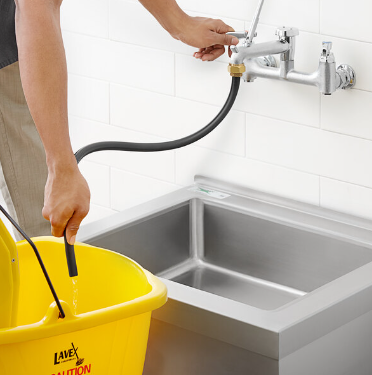
Measuring and Adjusting Faucet Height
It’s time to get practical! Armed with a measuring tape and a determination to conquer mop sink faucet height, let’s learn how to measure the current height and, more importantly, how to adjust it to fit our needs perfectly.
Step-by-Step Guide to Measuring Current Faucet Height
Clear the Area
Before you start measuring, ensure that the mop sink area is free of any obstacles and cleaning equipment.
Find the Reference Point
Locate the point where the faucet is attached to the sink.
Measure from the Base
Place the end of the measuring tape at the base of the faucet and extend it vertically upward until you reach the faucet’s spout or tip.
Record the Measurement
Note down the measurement in inches or centimeters.
Read more: How to Unclog a Bathroom Sink – The Expert Approach
How to Make Adjustments for an Ideal Mop Sink Faucet Height
Choose the Right Faucet Type
If the current faucet is not adjustable or cannot be positioned at the desired height, consider replacing it with a suitable faucet that meets your requirements.
Adjust the Mounting Bracket
Many faucets come with adjustable mounting brackets that allow you to change the faucet’s height. Loosen the screws on the bracket and reposition the faucet to the desired height. Tighten the screws securely once the adjustment is made.
Extend the Water Supply Lines
If you need to raise the faucet higher than the existing supply lines allow, you may need to extend the water supply lines. Consult a plumber for this task to ensure proper installation and prevent leaks.
Read more: How To Remove a Bathroom Sink Stopper
Tools Required for Mop Sink Faucet Height Modification
- Adjustable Wrench: For loosening and tightening nuts and bolts.
- Screwdriver: To adjust the mounting bracket and secure the faucet in place.
- Measuring Tape: To measure the current mop sink faucet height accurately.
- Plumbers’ Tape: To prevent leaks when reassembling the faucet components.
Safety Standards and Regulations
Ah, safety – an essential aspect of any workplace, and mop sink faucets are no exception. Imagine a faucet set at an unsafe height, causing splashes and spills that lead to slippery floors and potential accidents.
Yikes! Let’s delve into relevant safety regulations, ensuring our faucet heights comply with health and safety guidelines. This way, we can mop our worries away and focus on the job at hand.

Read more: Bidet Water Pressure Too High (How to Fix It)
Overview of Relevant Safety Regulations
In the United States, OSHA sets guidelines to ensure workplace safety, and these include regulations for mop sinks and their faucets.
According to OSHA, mop sink faucet height should be at a comfortable working level, and the sink should be designed to prevent backsplash and spills.
Compliance with Health and Safety Guidelines
To comply with OSHA regulations and ensure a safe working environment, establishments must regularly inspect their mop sink faucets for any issues related to height, stability, and water flow.
Employers should also provide training to employees on the correct use of mop sinks and faucets to minimize accidents.
Reducing the Risk of Accidents with Proper Faucet Height
By adhering to safety guidelines and maintaining the appropriate mop sink faucet height, businesses can significantly reduce the risk of accidents and injuries.
A well-placed faucet prevents unnecessary bending, reaching, and straining, contributing to a safer and more efficient workspace.
Read more: How To Replace/Change a Bathroom Sink Faucet
Common Mistakes to Avoid
Mistakes – we all make them, but when it comes to mop sink faucet height, let’s learn from others’ mishaps. I’ll guide you on avoiding excessively high or low faucet heights, ensuring our faucets align perfectly with our needs.
And let’s not forget the importance of proper positioning to prevent any future plumbing headaches.
Avoiding Excessively High or Low Faucet Heights
As we discussed earlier, an excessively high faucet can cause splashing, leading to slippery floors and potential accidents.
On the other hand, a faucet set too low can cause physical discomfort and strain, affecting productivity and employee morale. Strike the perfect balance to create a harmonious cleaning experience.
Ensuring Proper Alignment and Positioning of the Faucet
When adjusting mop sink faucet height, ensure that the faucet spout is aligned directly above the center of the sink basin. This alignment prevents water from splashing outside the sink, maintaining a dry and safe environment.
Additionally, check that the faucet is securely attached to the sink to prevent any wobbling or instability.
Read more: How to Remove Mold Around Your Bathroom Fan
Addressing Potential Plumbing Issues Related to Faucet Height
During the adjustment process, keep an eye out for any plumbing issues, such as leaks or weak water pressure. Address these issues promptly to avoid further complications and ensure smooth and uninterrupted water flow.
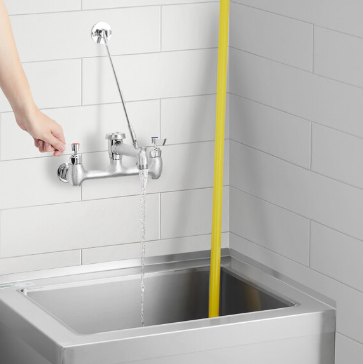
Read more: Can You Use Waterproof Bathroom Paint Instead Of Tiles?
Choosing the Right Mop Sink Faucet
With so many options out there, choosing the perfect mop sink faucet might seem overwhelming. But worry not! I’ll walk you through the essential features to look for and the different types available in the market.
Armed with this knowledge, you’ll be able to evaluate and pick the best faucet for your specific needs and budget, turning the chore of faucet selection into a fun adventure!
Features to Look for in a Mop Sink Faucet
Height Adjustment
Opt for a faucet with an adjustable height feature, allowing you to customize the faucet’s position to suit user preferences.
Spout Reach
Consider the spout’s reach to ensure it extends over the sink basin adequately, preventing unnecessary splashing outside the sink.
Faucet Handles
Choose between single and dual-handle faucets based on user preference and ease of use.
Construction Material
Look for faucets made from durable materials, such as brass or stainless steel, to ensure longevity and resistance to corrosion.
Water Flow Rate
Check the faucet’s flow rate to ensure it meets your cleaning needs while conserving water.
Read more: How Long Do Bathroom Scales Last?
Different Types of Faucets Available in the Market
Wall-Mounted Faucets
These faucets are attached to the wall above the sink and provide flexibility in height adjustment.
Deck-Mounted Faucets
Deck-mounted faucets are attached directly to the sink deck or countertop and are a popular choice for smaller sinks.
Pre-Rinse Faucets
Ideal for heavy-duty cleaning, pre-rinse faucets come with a high-pressure spray head to tackle stubborn grime.
Read more: Why Does Your Bathroom Smell Like Paint Thinner?
Evaluating the Best Faucet for Specific Needs and Budgets
As you browse through various faucet options, consider your specific cleaning tasks, the frequency of use, and your budget constraints.
Investing in a high-quality faucet that meets your needs and lasts for years is a wise decision.
Maintenance and Care Tips
Now that we’ve chosen the ideal faucet, it’s time to take care of it like a true cleaning connoisseur.
Regular maintenance and proper care can extend the faucet’s lifespan and ensure it operates smoothly for years to come.
Regular Cleaning and Inspection Routines
Incorporate faucet cleaning and inspection into your regular maintenance routine. Wipe down the faucet with a mild detergent regularly to remove grime and prevent the build-up of mineral deposits.
Additionally, inspect the faucet for any signs of leaks or damage and address issues promptly.
Read more: Are Bathroom Rugs Out of Style?
Addressing Faucet Leaks and Malfunctions Promptly
Don’t ignore a leaky faucet! A leak not only wastes water but can also lead to costly water damage and mold growth.
Repair or replace any malfunctioning components, such as washers, gaskets, or cartridges, to prevent further damage.
Prolonging the Lifespan of the Faucet Through Proper Care
Avoid using harsh chemicals or abrasive cleaning agents on the faucet surface, as these can damage the finish. Instead, use mild, non-abrasive cleaners to maintain the faucet’s shine and appearance.
Additionally, store and handle cleaning equipment carefully to prevent accidental damage to the faucet.
Real-Life Case Studies
Let’s take a journey into the real world and discover how businesses have benefited from optimal faucet height.
From success stories that show the power of ergonomics to cautionary tales illustrating the consequences of improper faucet height, these case studies will provide valuable insights and lessons.
Read more: Why Does My Bathroom Sink Smells Like Sewer
Examples of Businesses Benefiting from Optimal Faucet Height
Restaurant Kitchen
A busy restaurant kitchen implemented proper faucet height adjustments, leading to improved efficiency and reduced strain on their kitchen staff. The chefs and cleaning crew reported increased satisfaction and a decrease in work-related injuries.
Hospital Janitorial Department
A hospital’s janitorial department adjusted faucet heights to comply with safety standards. This reduced water spillage and created a safer environment for the staff, patients, and visitors.

Read more: How To Replace/Change a Bathroom Sink Faucet
Case Studies Illustrating the Consequences of Improper Faucet Height
Office Building Restrooms
An office building had several restroom sinks with improperly positioned faucets, causing excessive splashing and slippery floors. The management received complaints from employees, and they later discovered that these accidents were caused by the improper faucet height.
Educational Institution
A school’s custodial staff struggled with backaches and discomfort due to low faucet heights. After making adjustments based on ergonomic principles, the cleaning staff experienced improved job satisfaction and productivity.
Lessons Learned from Real-World Scenarios
From these real-world case studies, we learn that seemingly small details, like faucet height, can have a significant impact on efficiency, safety, and employee well-being.
By prioritizing proper faucet height and complying with safety standards, businesses can create a better work environment and enhance overall productivity.
Read more: Can a Toilet and Sink Share the Same Drain?
Conclusion
And there you have it, folks! We’ve journeyed through the world of mop sink faucets, discovering the secrets to optimal performance and safety. Remember, the seemingly small details matter, and faucet height is no exception.
By choosing the right height, aligning the faucet correctly, and adhering to safety standards, we can turn the chore of cleaning into a satisfying, efficient workspace.
So, let’s raise our mops high and cheers to the magic of ergonomic faucet heights! Happy cleaning, everyone!
Read more: Can a Toilet and Sink Share the Same Drain?
Why does mop sink faucet height matter?
Mop sink faucet height is crucial for ergonomic efficiency and safety. Incorrect heights can lead to challenges such as excessive splashing, discomfort, and potential accidents. Proper height considerations, influenced by user comfort and cleaning tasks, contribute to a seamless and secure cleaning experience.
What is the optimal height for a mop sink faucet?
The ideal height for a mop sink faucet generally falls between 36 to 42 inches (91 to 107 cm) above the floor. This range ensures a comfortable working position for most users, prioritizing user comfort, safety, and practicality in the workspace.


